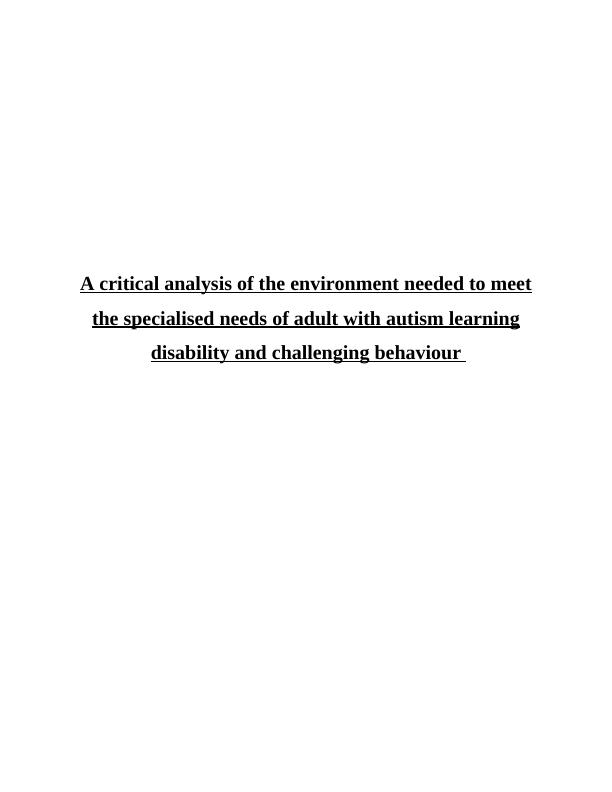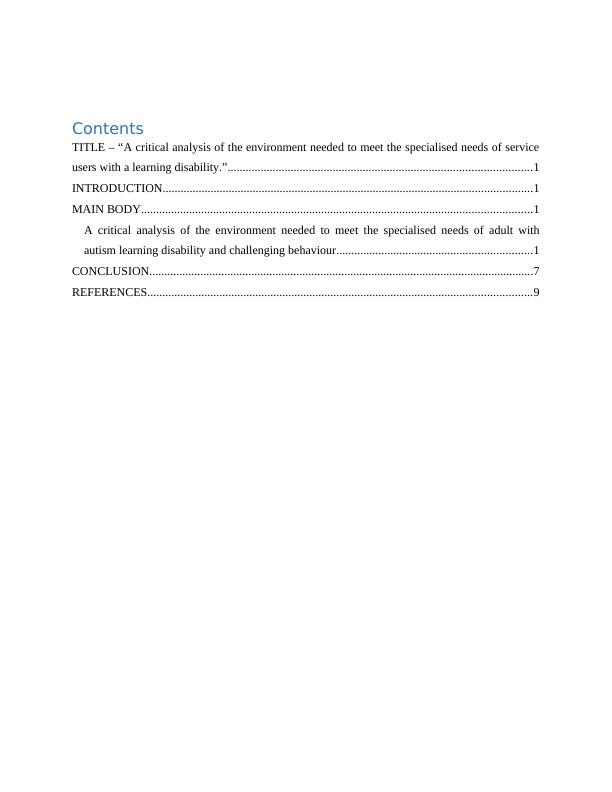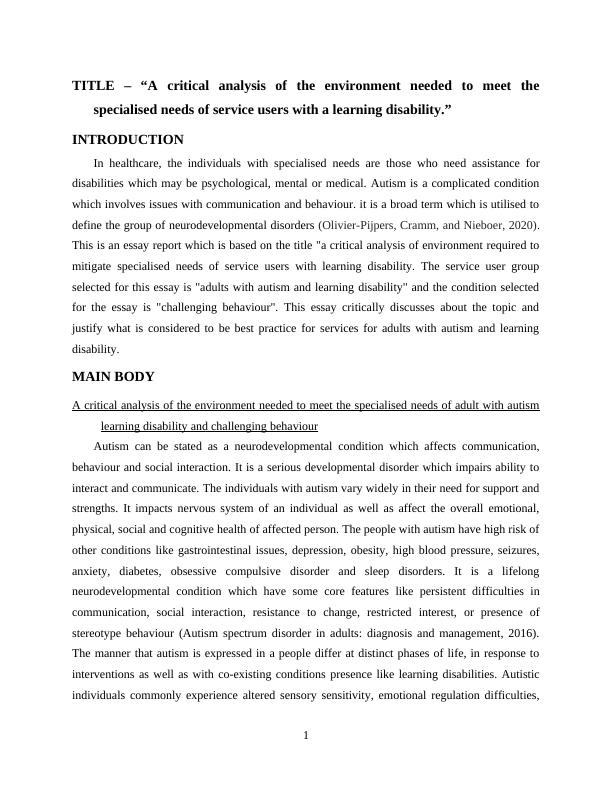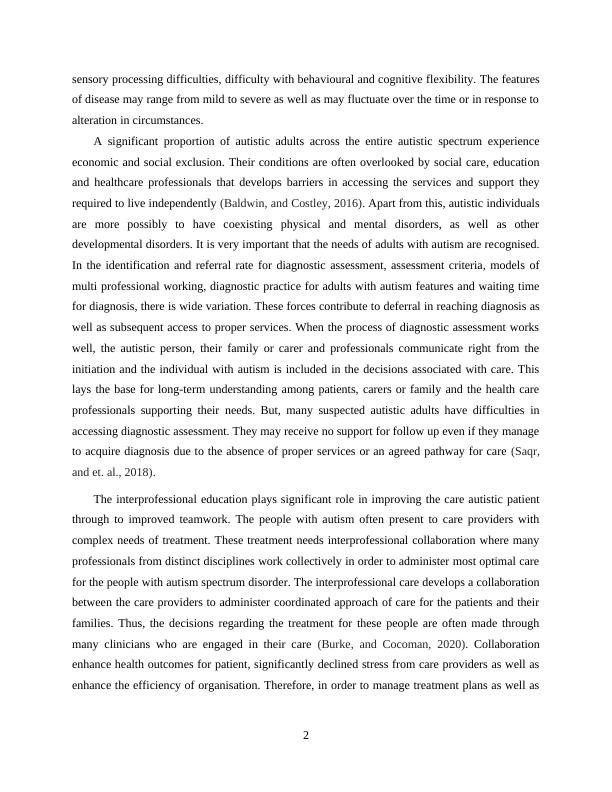A critical analysis of the environment needed to meet the specialised needs of adult with autism learning disability and challenging behaviour
Added on 2022-12-27
12 Pages4012 Words92 Views
A critical analysis of the environment needed to meet
the specialised needs of adult with autism learning
disability and challenging behaviour
the specialised needs of adult with autism learning
disability and challenging behaviour

Contents
TITLE – “A critical analysis of the environment needed to meet the specialised needs of service
users with a learning disability.”.....................................................................................................1
INTRODUCTION...........................................................................................................................1
MAIN BODY..................................................................................................................................1
A critical analysis of the environment needed to meet the specialised needs of adult with
autism learning disability and challenging behaviour.................................................................1
CONCLUSION................................................................................................................................7
REFERENCES................................................................................................................................9
TITLE – “A critical analysis of the environment needed to meet the specialised needs of service
users with a learning disability.”.....................................................................................................1
INTRODUCTION...........................................................................................................................1
MAIN BODY..................................................................................................................................1
A critical analysis of the environment needed to meet the specialised needs of adult with
autism learning disability and challenging behaviour.................................................................1
CONCLUSION................................................................................................................................7
REFERENCES................................................................................................................................9

TITLE – “A critical analysis of the environment needed to meet the
specialised needs of service users with a learning disability.”
INTRODUCTION
In healthcare, the individuals with specialised needs are those who need assistance for
disabilities which may be psychological, mental or medical. Autism is a complicated condition
which involves issues with communication and behaviour. it is a broad term which is utilised to
define the group of neurodevelopmental disorders (Olivier-Pijpers, Cramm, and Nieboer, 2020).
This is an essay report which is based on the title "a critical analysis of environment required to
mitigate specialised needs of service users with learning disability. The service user group
selected for this essay is "adults with autism and learning disability" and the condition selected
for the essay is "challenging behaviour". This essay critically discusses about the topic and
justify what is considered to be best practice for services for adults with autism and learning
disability.
MAIN BODY
A critical analysis of the environment needed to meet the specialised needs of adult with autism
learning disability and challenging behaviour
Autism can be stated as a neurodevelopmental condition which affects communication,
behaviour and social interaction. It is a serious developmental disorder which impairs ability to
interact and communicate. The individuals with autism vary widely in their need for support and
strengths. It impacts nervous system of an individual as well as affect the overall emotional,
physical, social and cognitive health of affected person. The people with autism have high risk of
other conditions like gastrointestinal issues, depression, obesity, high blood pressure, seizures,
anxiety, diabetes, obsessive compulsive disorder and sleep disorders. It is a lifelong
neurodevelopmental condition which have some core features like persistent difficulties in
communication, social interaction, resistance to change, restricted interest, or presence of
stereotype behaviour (Autism spectrum disorder in adults: diagnosis and management, 2016).
The manner that autism is expressed in a people differ at distinct phases of life, in response to
interventions as well as with co-existing conditions presence like learning disabilities. Autistic
individuals commonly experience altered sensory sensitivity, emotional regulation difficulties,
1
specialised needs of service users with a learning disability.”
INTRODUCTION
In healthcare, the individuals with specialised needs are those who need assistance for
disabilities which may be psychological, mental or medical. Autism is a complicated condition
which involves issues with communication and behaviour. it is a broad term which is utilised to
define the group of neurodevelopmental disorders (Olivier-Pijpers, Cramm, and Nieboer, 2020).
This is an essay report which is based on the title "a critical analysis of environment required to
mitigate specialised needs of service users with learning disability. The service user group
selected for this essay is "adults with autism and learning disability" and the condition selected
for the essay is "challenging behaviour". This essay critically discusses about the topic and
justify what is considered to be best practice for services for adults with autism and learning
disability.
MAIN BODY
A critical analysis of the environment needed to meet the specialised needs of adult with autism
learning disability and challenging behaviour
Autism can be stated as a neurodevelopmental condition which affects communication,
behaviour and social interaction. It is a serious developmental disorder which impairs ability to
interact and communicate. The individuals with autism vary widely in their need for support and
strengths. It impacts nervous system of an individual as well as affect the overall emotional,
physical, social and cognitive health of affected person. The people with autism have high risk of
other conditions like gastrointestinal issues, depression, obesity, high blood pressure, seizures,
anxiety, diabetes, obsessive compulsive disorder and sleep disorders. It is a lifelong
neurodevelopmental condition which have some core features like persistent difficulties in
communication, social interaction, resistance to change, restricted interest, or presence of
stereotype behaviour (Autism spectrum disorder in adults: diagnosis and management, 2016).
The manner that autism is expressed in a people differ at distinct phases of life, in response to
interventions as well as with co-existing conditions presence like learning disabilities. Autistic
individuals commonly experience altered sensory sensitivity, emotional regulation difficulties,
1

sensory processing difficulties, difficulty with behavioural and cognitive flexibility. The features
of disease may range from mild to severe as well as may fluctuate over the time or in response to
alteration in circumstances.
A significant proportion of autistic adults across the entire autistic spectrum experience
economic and social exclusion. Their conditions are often overlooked by social care, education
and healthcare professionals that develops barriers in accessing the services and support they
required to live independently (Baldwin, and Costley, 2016). Apart from this, autistic individuals
are more possibly to have coexisting physical and mental disorders, as well as other
developmental disorders. It is very important that the needs of adults with autism are recognised.
In the identification and referral rate for diagnostic assessment, assessment criteria, models of
multi professional working, diagnostic practice for adults with autism features and waiting time
for diagnosis, there is wide variation. These forces contribute to deferral in reaching diagnosis as
well as subsequent access to proper services. When the process of diagnostic assessment works
well, the autistic person, their family or carer and professionals communicate right from the
initiation and the individual with autism is included in the decisions associated with care. This
lays the base for long-term understanding among patients, carers or family and the health care
professionals supporting their needs. But, many suspected autistic adults have difficulties in
accessing diagnostic assessment. They may receive no support for follow up even if they manage
to acquire diagnosis due to the absence of proper services or an agreed pathway for care (Saqr,
and et. al., 2018).
The interprofessional education plays significant role in improving the care autistic patient
through to improved teamwork. The people with autism often present to care providers with
complex needs of treatment. These treatment needs interprofessional collaboration where many
professionals from distinct disciplines work collectively in order to administer most optimal care
for the people with autism spectrum disorder. The interprofessional care develops a collaboration
between the care providers to administer coordinated approach of care for the patients and their
families. Thus, the decisions regarding the treatment for these people are often made through
many clinicians who are engaged in their care (Burke, and Cocoman, 2020). Collaboration
enhance health outcomes for patient, significantly declined stress from care providers as well as
enhance the efficiency of organisation. Therefore, in order to manage treatment plans as well as
2
of disease may range from mild to severe as well as may fluctuate over the time or in response to
alteration in circumstances.
A significant proportion of autistic adults across the entire autistic spectrum experience
economic and social exclusion. Their conditions are often overlooked by social care, education
and healthcare professionals that develops barriers in accessing the services and support they
required to live independently (Baldwin, and Costley, 2016). Apart from this, autistic individuals
are more possibly to have coexisting physical and mental disorders, as well as other
developmental disorders. It is very important that the needs of adults with autism are recognised.
In the identification and referral rate for diagnostic assessment, assessment criteria, models of
multi professional working, diagnostic practice for adults with autism features and waiting time
for diagnosis, there is wide variation. These forces contribute to deferral in reaching diagnosis as
well as subsequent access to proper services. When the process of diagnostic assessment works
well, the autistic person, their family or carer and professionals communicate right from the
initiation and the individual with autism is included in the decisions associated with care. This
lays the base for long-term understanding among patients, carers or family and the health care
professionals supporting their needs. But, many suspected autistic adults have difficulties in
accessing diagnostic assessment. They may receive no support for follow up even if they manage
to acquire diagnosis due to the absence of proper services or an agreed pathway for care (Saqr,
and et. al., 2018).
The interprofessional education plays significant role in improving the care autistic patient
through to improved teamwork. The people with autism often present to care providers with
complex needs of treatment. These treatment needs interprofessional collaboration where many
professionals from distinct disciplines work collectively in order to administer most optimal care
for the people with autism spectrum disorder. The interprofessional care develops a collaboration
between the care providers to administer coordinated approach of care for the patients and their
families. Thus, the decisions regarding the treatment for these people are often made through
many clinicians who are engaged in their care (Burke, and Cocoman, 2020). Collaboration
enhance health outcomes for patient, significantly declined stress from care providers as well as
enhance the efficiency of organisation. Therefore, in order to manage treatment plans as well as
2

End of preview
Want to access all the pages? Upload your documents or become a member.
Related Documents
Ways to Ensure Active Participation of Individuals with Autistic Spectrum Conditionslg...
|6
|932
|53
Autism and Learning Disability: Impact, Causes, and Strategieslg...
|9
|2322
|200
NVQ5 for Health and Social Carelg...
|14
|4812
|47
Role of Teacher Assistant in Special Education Schoollg...
|41
|15601
|244
Autism Spectrum Disorderlg...
|9
|1772
|117
Effective Methods to Encourage Children with Autism to Interact with Otherslg...
|12
|2618
|80